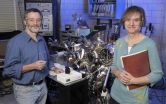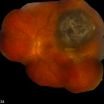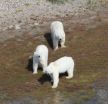(Press-News.org) AMES, Iowa – Patricia Thiel of Iowa State University and the Ames Laboratory put a box of tissues to the right, a stack of coasters to the middle and a trinket box to the left.
"Nature," she said of her table-top illustration, "doesn't want lots of little things." So Thiel grabbed the smaller things and slid them into a single pile next to the bigger tissue box. "Nature wants one big thing all together, like this."
Thiel, an Iowa State Distinguished Professor of Chemistry and a faculty scientist for the U.S. Department of Energy's Ames Laboratory, and James Evans, an Iowa State professor of physics and astronomy and a faculty scientist for the Ames Laboratory, describe that process in the Oct. 29 issue of the journal Science.
The paper, "A Little Chemistry Helps the Big Get Bigger," is in the journal's Perspectives section. It describes a process called coarsening. That's when "a group of objects of different sizes transforms into fewer objects with larger average size, such that 'the big get bigger,'" says the paper. Examples of the process include the geologic formation of gemstones, the degradation of pharmaceutical suspensions and the manufacture of structural steels.
Thiel and Evans were invited to write the paper after Thiel delivered a talk at an American Chemical Society meeting about their studies of coarsening, an emerging field in surface chemistry.
Thiel worked with Mingmin Shen, a former Iowa State doctoral student who is now a post-doctoral research associate at Pacific Northwest National Laboratory in Richland, Wash., on the experimental side of the coarsening research. Evans worked with Da-Jiang Liu, an associate scientist at the Ames Laboratory, on the theoretical side of the project.
The researchers, with the support of grants from the National Science Foundation, have been using scanning tunneling microscope technology – an instrument that allows them to see individual atoms – to study how coarsening happens on the surface of objects.
They've studied nanoscale particles grown on the surface of silver and how adding sulfur can increase coarsening. They're trying to learn the mechanism of that increase and understand the nature of the messengers that move atoms during the coarsening process.
What Thiel and Evans are looking for is a general principle that explains what they call additive-enhanced coarsening. To do that, Thiel said they still need to collect and analyze data from more coarsening systems.
Evans said a better understanding of the coarsening process can help researchers develop small structures – including nanoscale technologies, catalysts or drug suspensions – that resist coarsening and are therefore more durable. A better understanding could also help researchers manipulate coarsening to develop structures with a very narrow distribution of particle sizes, something important to some nanotechnologies.
"When we're building something on a small scale, for it to be useful, it has to be robust, it has to survive," Evans said. "And one thing we're looking at is the stability of the very tiny structures that are crucial to nanoscale technologies."
INFORMATION:
Iowa State, Ames Laboratory scientists advance the understanding of the big getting bigger
2010-11-05
ELSE PRESS RELEASES FROM THIS DATE:
Global food safety: Keeping food safe from farm to table
2010-11-05
Washington, DC – November 2, 2010 – Food safety problems can arise at any of multiple stages of food production, and illnesses that result from them are frequently not detected or reported, according to a new report from the American Academy of Microbiology.
The report, "Global Food Safety: Keeping Food Safe from Farm to Table," is based on a colloquium convened by the Academy in 2009. Colloquium participants with expertise in microbiology, public health, food science, and economics reviewed the current state of affairs in microbiological food safety around the world.
The ...
Gene identified for spread of deadly melanoma
2010-11-05
AUDIO:
Researchers at Washington University School of Medicine in St. Louis have identified a gene linked to the spread of melanoma of the eye. Although more research is needed, the researchers...
Click here for more information.
Researchers at Washington University School of Medicine in St. Louis have identified a gene linked to the spread of eye melanoma.
Although more research is needed, the researchers say the discovery is an important step in understanding why some ...
Missouri Botanical Garden researchers discover 8 new species in Boliva national parks
2010-11-05
(ST. LOUIS): Botanists at the Missouri Botanical Garden have described eight new plant species collected in the Madidi National Park and surrounding areas located on the eastern slopes of the Andes in northern Bolivia. The new species are from several different genera and families and are published in a recent edition of the Missouri Botanical Garden journal Novon.
Missouri Botanical Garden scientists and colleagues from the National Herbarium in La Paz, Bolivia describe Prestonia leco, Passiflora madidiana, Siphoneugena minima, Siphoneugena glabrata, Hydrocotyle apolobambensis, ...
Polar bears can't eat geese into extinction
2010-11-05
As the Arctic warms, a new cache of resources—snow goose eggs—may help sustain the polar bear population for the foreseeable future. In a new study published in an early online edition of Oikos, researchers affiliated with the Museum show that even large numbers of hungry bears repeatedly raiding nests over many years would have a difficult time eliminating all of the geese because of a mismatch in the timing of bear arrival on shore and goose egg incubation.
"There have been statements in popular literature indicating that polar bears can extirpate snow geese quickly ...
Pigs reveal secrets: New research shines light on Quebec industry
2010-11-05
Which are the best pieces of pork, what their texture is, how moist they are – the secrets pigs keep from even the most skilled butchers – are about to be revealed, thanks to a sophisticated new technique that has been developed by McGill University researchers in conjunction with Agriculture Canada and the pork industry. "This is about giving industry workers better tools to do their job," explained Dr. Michael Ngadi of McGill's Department of Bioresource Engineering. "Computer-aided analysis of meat will result in higher-quality jobs, optimal production, and exports that ...
Hard work improves the taste of food, Johns Hopkins study shows
2010-11-05
It's commonly accepted that we appreciate something more if we have to work hard to get it, and a Johns Hopkins University study bears that out, at least when it comes to food.
The study seems to suggest that hard work can even enhance our appreciation for fare we might not favor, such as the low-fat, low calorie variety. At least in theory, this means that if we had to navigate an obstacle course to get to a plate of baby carrots, we might come to prefer those crunchy crudités over the sweet, gooey Snickers bars or Peanut M&Ms more easily accessible via the office vending ...
Burning pain and itching governed by same nerve cells
2010-11-05
There are disorders and conditions that entail increased itching and can be extremely troublesome for those suffering from it. The mechanisms behind itching are not well understood today. For one thing, what is it about scratching that relieves itching?
In the current study, which was performed on mice, the research team led by Professor Klas Kullander at the Department of Neuroscience examined the nerve cells that transfer heat pain. When these nerve cells had lost its capacity to signal, the mice reacted less to heat, as expected, but surprisingly they also started ...
UMD-led deep impact spacecraft successfully flies by comet Hartley 2
2010-11-05
COLLEGE PARK, Md. – The University of Maryland-led EPOXI mission successfully flew by comet Hartley 2 at 10 a.m. EDT today, and the spacecraft has begun returning images. Hartley 2 is the fifth comet nucleus visited by any spacecraft and the second one visited by the Deep Impact spacecraft.
Scientists and mission controllers are studying never-before-seen images of Hartley 2 appearing on their computer terminal screens. See images at: http://epoxi.umd.edu/
"We are all holding our breath to see what discoveries await us in the observations near closest approach," said ...
Researchers unlock the secret of bacteria's immune system
2010-11-05
Quebec City, November 4, 2010—A team of Université Laval and Danisco researchers has just unlocked the secret of bacteria's immune system. The details of the discovery, which may eventually make it possible to prevent certain bacteria from developing resistance to antibiotics, are presented in today's issue of the scientific journal Nature.
The team led by Professor Sylvain Moineau of Université Laval's Department of Biochemistry, Microbiology, and Bioinformatics showed that this mechanism, called CRISPR/Cas, works by selecting foreign DNA segments and inserting them ...
A 'brand' new world: Attachment runs thicker than money
2010-11-05
Can you forge an emotional bond with a brand so strong that, if forced to buy a competitor's product, you suffer separation anxiety? According to a new study from the USC Marshall School of Business, the answer is yes. In fact, that bond can be strong enough that consumers are willing to sacrifice time, money, energy and reputation to maintain their attachment to that brand.
"Brand Attachment and Brand Attitude Strength: Conceptual and Empirical Differentiation of Two Critical Brand Equity Drivers," a study published in the November issue of the Journal of Marketing, ...




